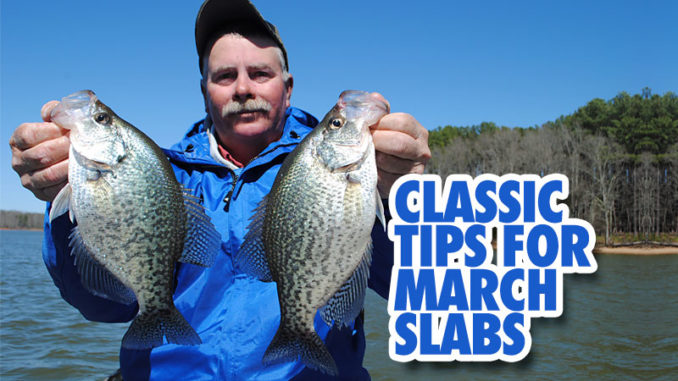
These six tips should help crappie fishermen clean up on Carolina slabs this month.
Crappie are among the favorite fish for many anglers in the Carolinas. Let’s face it: they’re fun to catch; you can catch them year-round; it doesn’t take an expensive boat or thousands of dollars of tackle. And last but not least, they taste good.
Carolina Sportsman sifted through its archives and came up with a handful of great tips for fishermen looking to have some fun and kick-start a fish fry. They all relate to fishing in the spring, when fish are getting ready to spawn and headed to the bank. Here they are:
Be sure you’re there when the crappie are
According to Brad Taylor, who guides on South Carolina’s Lake Murray, shallow-water crappie action doesn’t last for an extended period, but it’s sensational when it occurs.
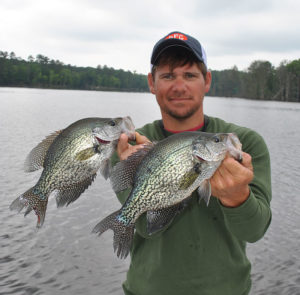
“When the big females get into the shallows, often by the end of March and sometimes earlier up the rivers, that’s prime time to catch slab crappie,” Taylor said. “My years of experience with crappie is that fish will move to the shoreline first, but still in slightly deeper water, and then migrate into the shallows by around the end of March and early April.
Taylor (803-331-1354) fishes jigs and/or minnows when fish are shallow.
“I vary color patterns on jigs when trolling. But when fishing shallow water with jigs, I’ll use a 12-foot rod with a float 2 feet or less depending on the cover being fished,” he said.
Fish around cover
“I specifically prefer a black/chartreuse jig for shallow-water fishing” he said. “But for those using a minnow, the key is to hook it in the tail, because they wiggle more and seem to be more attractive to crappie. That’s true whether I am fishing minnows shallow or tight-lining deeper water.
“I get in the shallow water and start probing around brush, logs, stumps, docks or any visible cover,” he said. “Sometimes, even a small twig sticking from the water in the shallows will be part of a much larger object under the water and can hold a lot of crappie. Don’t pass any potential target when working the shallows.
“When you get on some fish, keep working that area until the action slows, then start moving and hunting again. Typically, if you can get on a few places where shallow fish are located, you’ll be culling fish.
— Terry Madewell
Angling for spawners
A key to catching plenty of crappie as spring progresses is to understand that slabs don’t approach their spawning areas “at an angle,” according to veteran angler Ed Duke of Concord, N.C.
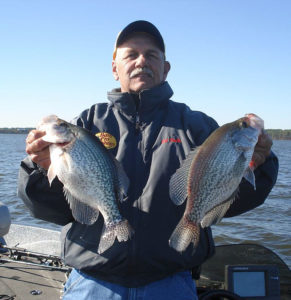
Duke is a former tournament promoter who manufactures Southern Crappie Rods. He said crappie move horizontally into their shallow spawning areas from nearby flats. They find the depth that provides a comfortable water temperature and wait for the right moment. Then, they move to the bank to drop their eggs.
“The biggest thing is, starting in late February and going through March, is never rule out a crappie being shallow,” said Duke. “They won’t spawn until the water temperature is in the 60s. But they’ll get up on that flat and make some false spawning runs.
“If a real cold front comes through, they may move back to deep water. But once they get on their spawning flat, they’ll stay there until it’s time.”
Duke said each reservoir has a “special” flat — or several — where crappie find all the perfect conditions for spawning. These areas are close to deep water, in the back of a creek or cove, a place where the current doesn’t come into play, and a place with a gravelly bottom.
“You’ve got to have that combination,” he said.
— Dan Kibler
Let’s get small
The frequent cold fronts that wash over the Carolinas from late February through March can cause crappie to halt their progression toward the shallows. They sink deep into brush or other cover and are hard to catch.
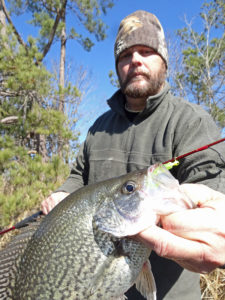
Tom Mundy of Fish Stalker Lures in Laurens, S.C., doesn’t sweat tight-lipped crappie. He simply turns to a finesse-type tactic.
“Bridges, boat docks, brush piles — it doesn’t matter,” Mundy said. “This time of year, it’s all about the art of finesse. I use a small bait, light line, an extremely sensitive rod, and I fish straight down to the fish. Put it right on his nose, and he’ll hit it.”
Mundy stumbled on the pattern when doing some field research for a soft-plastic bait he was considering marketing.
“I wanted a small bait that could be used finesse-style, similar to methods bass anglers used,” he said. “I also found that finesse fishing for crappie meant fishing deep into cover that crappie favored. Things like brush piles, logs and other woody debris.”
The trick was that the tip of the rod he was using was quivering as he reeled. Mundy uses super ultralight rods that incorporate a tip so fast that it is impossible to hold still — except when a crappie bites. He’s watching for the rod tip to stop quivering. That’s the result of a crappie gently inhaling the bait. With his tactics, Mundy is out to redefine the meaning of “finesse.”
— Phillip Gentry
Let the sun shine
Crappie pro Rod King of Durham, N.C., said crappie, like all wild things, are attuned to the angle of the sun. And that makes them head deep in early winter and shallow in late winter and early spring.
“Sunshine is the most important thing,” King said. “Crappies are looking to make a transition as the water warms up, heading toward 50 degrees. But that can be a couple of weeks early or late, depending on the weather.”
In late February, big female crappie start to move toward spawning flats. That’s because the angle of the sun offers a little more light each day. It triggers an urge to head for the banks to make deposits that ensure the survival of the species.
“When the sun starts to ascend more and the days get longer, crappie seem to recognize that, and bass as well,” King said. “It’s also kind of like deer in November. The angle of the sun and shorter days trigger the rut. And once it starts, it doesn’t stop, even when the weather changes.”
The sparks that set the crappie migration on fire during February and March will be warm fronts, sunshine and a southwest wind, King said.
“People say, ‘Go crappie fishing when the dogwoods bloom,’” he said. “But two or three days after the (water temperature) hits 50 degrees, the big females will be gone — a week at the most.
“Watch for south winds, sunshine and the water temperature hitting 50 degrees. It doesn’t matter when, February or March, if you want to catch the biggest crappie of the year.”
— Craig Holt
Color my world
Sometimes, a live bait stands out from the crowd. Fish are going to slam that bait first. And Chris Bullock of Kerr Crappie and Cats Guide Service makes sure his minnows stand out.
He dips them in Pautzke Bait Company’s Fire Dye, turning them red, gold, blue or chartreuse.
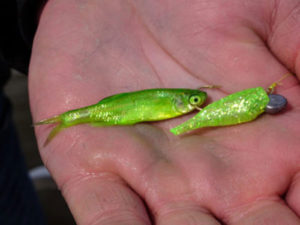
“Crappie are sight feeders,” said Bullock (252-902-4039). “They need to see what they’re going to eat before they pull up there and bite it. The farther away they can see it, the better off you are. If you’ve had a lot of rain and the water is stained, those chartreuse-dyed minnows are going to come out on top — no doubt about it.”
Bullock tested out Fire Dye a couple of years ago while tight-lining a spread of eight rods off the bow of his boat in stained water in the Eno River near Durham, N.C. With each rod, he used identical rigs, with jigs of different colors. Half the live minnows threaded on the jigs were natural, the other half dipped in Fire Dye chartreuse.
Bullock’s dyed minnows outperformed the others by nearly 5-to-1. Whether the jig color was black, Cajun cricket, key lime pie or even chartreuse, the chartreuse minnows were favored. After he deemed the test conclusive, he outfitted all jigs with the chartreuse minnows. And they filled a cooler full of crappie.
To duplicate that kind of success, anglers must do what they often do poorly — read the directions. While it is tempting to just fill a bucket with minnows and water and pour in the dye, that often leads to wasted effort.
“If you put too much water in, they either won’t dye quickly or dye at all,” Bullock said. “It has to be just enough to aerate, about 3 to 4 inches deep, then you pour in the bottle. After about an hour to an hour-and-a-half, you dip them out and put them in clean water. They’ll stay dyed and living the rest of the day.”
Instructions are to add one bottle of Fire Dye to 12 ounces of water for a long soak. You add one bottle to 32 ounces of water for a short soak.
Bullock favors chartreuse in stained water. But red, gold, and blue are productive in other circumstances — just like different jig colors. Anglers should experiment and find the palate preference of crappie on any given day.
— Dan Kibler
Long-lining basics for crappie
-
- Don’t stop. Unlike tight-lining, in long-lining, the speed of the boat determines the depth of the baits and/or lures. Stopping over underwater cover too long will cause you to lose your religion when every line hangs up at once.
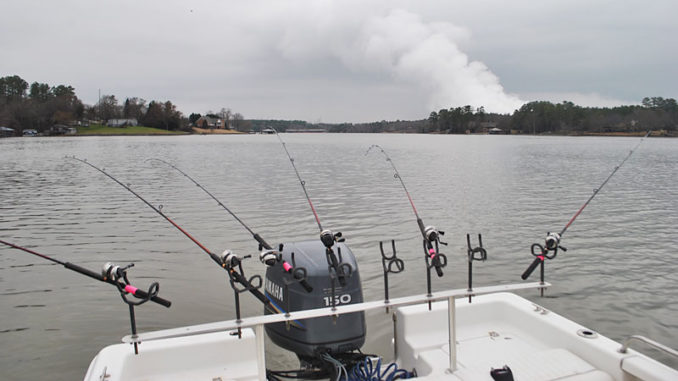
- Work from the rod holder. Multiple hook-ups, snags and crossed lines will often occur at once. Work each rod individually, then put it back in the holder.
- Avoid straight lines. Trolling in straight lines will catch super-aggressive fish, but a better approach is to zig-zag. During a turn, inside baits will drop and outside baits will rise, often helping you to zero in on the depth the fish are holding.
- Stay in your lane. When reeling in a fish, get it to the surface and bring in into the appropriate “lane” to prevent it from crossing lines to avoid tangles.
- Look for bait, not fish. Crappie may suspend just below the surface and not show up on sonar when checking out an area to troll. The presence of bait, preferably in small pods or schools rather than thick layers, will indicate that predator fish are down there stirring things up.
- Keep track of colors. Start with eight to 10 different colors and keep track of which rod sports which color by hanging a duplicate jig/skirt on that rod holder. As the day progresses, a color pattern will emerge.
- Use a net. The pressure of being “towed” behind the boat will wallow out hook holes in the fish’s mouth. Slide a long-handled net under the fish, especially bigger ones, before taking the pressure off at the surface. ■
— Phillip Gentry

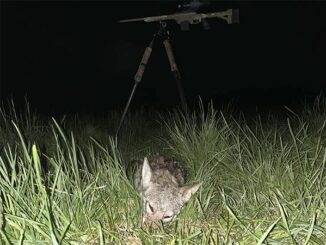
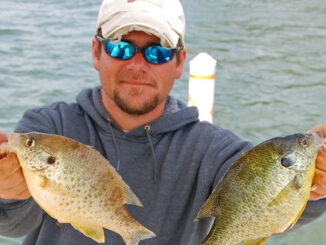
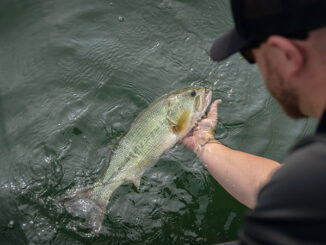
Be the first to comment